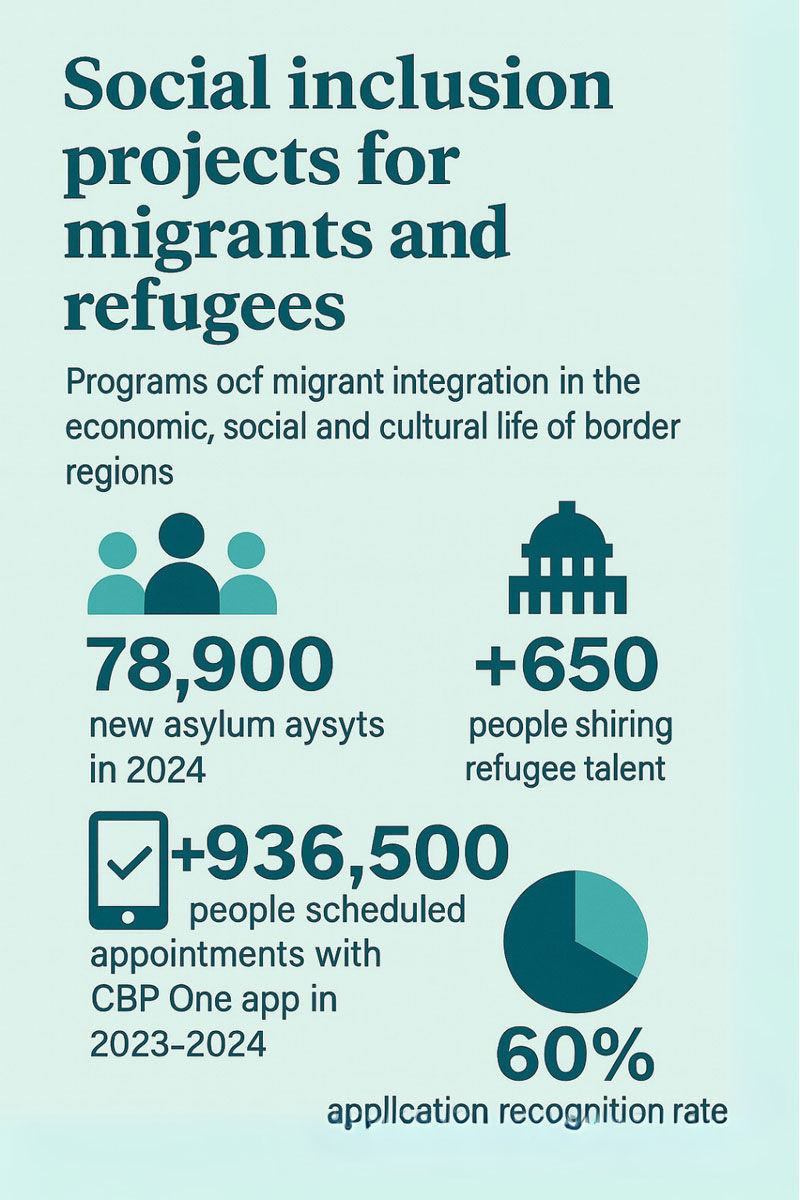A border that integrates. Migrant inclusion already drives economy and culture in 2024 and 2025 will be decisive
- Editorial

- Sep 5
- 3 min read

On the U.S.–Mexico border, 2024 sent a clear signal: well-designed integration programs not only reduce vulnerabilities, they also generate economic value and social cohesion. Mexico closed the year with 78,900 new asylum requests, 44% fewer than in 2023, maintaining recognition rates above 60% and reducing the average resolution time to 170 daysthanks to the digitalization of COMAR. But the 97% cut in Humanitarian Visitor Cards restricted access to formal work and strained shelters —in Mexico City, occupancy spiked by 500%— reminding us that inclusion depends as much on public policy as on viable procedures.
The Local Integration Program (PIL) led by UNHCR consolidated its role as a driver of socioeconomic insertion: nearly 50,000 participants in 2024 and 110,000 people supported to find employment in host cities, with more than 650 companies hiring refugee talent. Since 2016, the total number relocated has reached nearly 50,000, and in 2024 alone almost 13,000 more were added. Mexico’s Ministry of Welfare also assumed responsibility for initial financial support, a key step toward fiscal sustainability. These partnerships already generate hundreds of millions of pesos in tax revenue and, most importantly, stabilize life trajectories.
In the northern border corridor, technology is helping organize flows. The CBP One app enabled over 936,500 peopleto schedule appointments at U.S. ports of entry between January 2023 and December 2024, reducing the role of smuggling networks and allowing safer referrals. In parallel, the CHNV parole processes (for Cuba, Haiti, Nicaragua, and Venezuela) facilitated the regular arrival of 531,690 people with prior security checks and eligibility for subsequent permits, speeding up their incorporation into host communities.
The economic link is tangible. Companies in Mexico report filling vacancies faster when they coordinate with PIL and local job boards; in the U.S., labor demand in key sectors continues to rely on regular, verified channels. However, E-Verify —the U.S. employment verification system— showed vulnerabilities to identity theft, as revealed by recent investigations and raids. This blind spot leaves both workers and employers exposed and urgently requires modernization with biometric safeguards and better interoperability with state databases.

Institutional innovation also advanced in Mexico: COMAR Digital now offers case traceability and notifications, while UNHCR and local governments expanded agreements with universities and legal clinics for legal and psychosocial assistance. Still, banking and KYC barriers persist —many banks do not accept migrant documents— pushing people toward informality and undermining the benefits of regularization. The solution lies in clear regulatory guidelines for opening accounts and verifiable digital identities that link migration documentation to financial services and social security.
2025: Where the Game Will Be Played
The year begins with regulatory uncertainty in the U.S. and state-level decisions that affect migrant human capital. For example, in Texas a recent ruling against the Texas Dream Act cut educational benefits for undocumented youth, with economic impacts projected in lost wages and lower productivity. In this environment, border municipalities must safeguard early employability (language classes, skills certification, fast-track recognition of technical degrees) and strengthen protection mechanisms against trafficking and labor exploitation.

The smart binational agenda for 2025 rests on three pillars:
Policy: coordinate labor mobility corridors (e.g., the Labor Mobility Mechanism expanded to the U.S. and Canada) with transparent quotas and quarterly evaluations;
Economy: provide incentives for companies to formally hire refugees and adopt ESG metrics measuring retention, productivity, and wages;
Technology: scale up COMAR Digital and CBP One with capacity analytics and interoperable identity verification that reduces fraud and accelerates permits. If municipalities, universities (such as COLEF and binational centers in Arizona), and the private sector sustain this architecture, 2025 can turn inclusion into a competitive advantage for border regions, diversifying supply chains, culture, and civic life.
The evidence from 2024 suggests that early integration pays: less humanitarian pressure, more formal employment, and higher tax revenues. But without bank-accepted documents, timely permits, and educational pathways, that dividend erodes. It is up to Mexico and the United States to safeguard what already works —PIL, CBP One, business–university alliances— and to close regulatory and technological gaps. Inclusion is not a concession: it is industrial policy for the border.
Written by: Editorial




Comments